日本福岛核电站再次爆炸 英文报道
关于日本核污水的初中英语作文100词
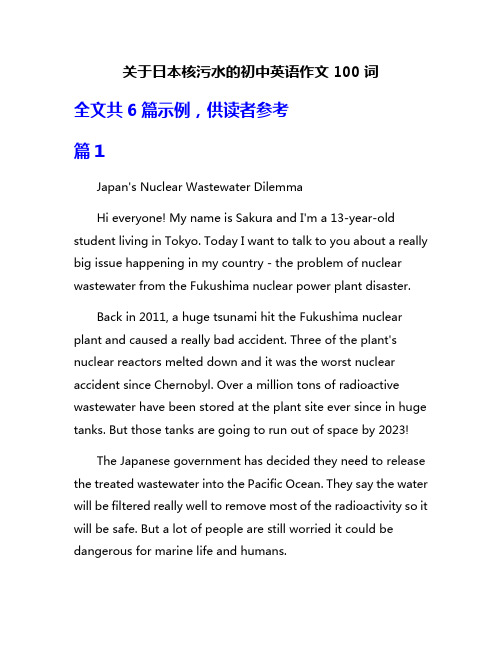
关于日本核污水的初中英语作文100词全文共6篇示例,供读者参考篇1Japan's Nuclear Wastewater DilemmaHi everyone! My name is Sakura and I'm a 13-year-old student living in Tokyo. Today I want to talk to you about a really big issue happening in my country - the problem of nuclear wastewater from the Fukushima nuclear power plant disaster.Back in 2011, a huge tsunami hit the Fukushima nuclear plant and caused a really bad accident. Three of the plant's nuclear reactors melted down and it was the worst nuclear accident since Chernobyl. Over a million tons of radioactive wastewater have been stored at the plant site ever since in huge tanks. But those tanks are going to run out of space by 2023!The Japanese government has decided they need to release the treated wastewater into the Pacific Ocean. They say the water will be filtered really well to remove most of the radioactivity so it will be safe. But a lot of people are still worried it could be dangerous for marine life and humans.The fishing industry in Japan and neighboring countries like South Korea are scared the wastewater release will make people too afraid to buy their seafood because they think it's contaminated. They rely on fishing to make a living so this could really hurt their businesses.Environmental groups are also very concerned that releasing the wastewater will harm the ocean's fragile ecosystem. Even if radiation levels are low, they worry it could build up over time and cause genetic mutations or other problems for sea creatures.On the other hand, some scientists say that diluting the wastewater in the vastness of the Pacific ocean will make radiation levels negligible and no more dangerous than natural background radiation we get exposed to already. The operator of the plant says they've been strictly following treatment procedures to make the water safe.It's such a tough decision because there aren't really any perfect solutions. Storing the water indefinitely also comes with risks of tank leaks or other accidents. Moving it off-site is extremely difficult because of the sheer volume involved.In my opinion, I can understand both sides of the argument. I'm worried about potential environmental damage, but I also know we can't keep storing the water forever. Maybe there's away to capture and reuse the tritium, which is the main radioactive element left after treatment?I really hope the Japanese government Studies all the evidence extremely carefully and comes up with the safest plan possible that protects both people and nature. Bringing in more international oversight could help ensure the release is done properly.This whole situation shows how nuclear power always comes with risks that we have to take very seriously. Maybe it would be better to invest more in safer renewable energy sources going forward to avoid nuclear disasters entirely?Those are just my thoughts as a kid from Japan watching this situation closely. It's a very complex issue with no easy answers. I just hope the grown-ups in charge make wise choices for the future of our planet. Please let me know what you think too! Thanks for reading.篇2The Big Problem with Japan's Nuclear WastewaterHi everyone! My name is Sakura and I'm a 13-year-old student in Tokyo. Today I want to talk to you about a huge issuewe are facing here in Japan - the problem of nuclear wastewater from the Fukushima nuclear disaster.Back in 2011, a massive earthquake and tsunami hit the Fukushima Daiichi nuclear power plant. It was one of the worst nuclear accidents ever! Three of the plant's reactors melted down and there were explosions and radiation leaks. It was a total nightmare.Over a million tons of radioactive wastewater has been stored at the plant since then. The water was used to cool down the melted reactor cores to prevent further disasters. But now, nearly 12 years later, the plant is running out of space to store all that contaminated water!The Japanese government has decided to release the treated wastewater into the Pacific Ocean over many years. They say it will be filtered to remove most of the radioactive particles, making it safe to dump into the sea.But many people are really worried and angry about this plan. Neighboring countries like China and South Korea strongly oppose it. They are concerned it could pollute fishing areas and harm the marine environment and food supply. Even here in Japan, there is a lot of public opposition, especially from local fishermen.Personally, I'm quite worried too. We learned all about the dangers of radiation in science class. It can cause cancers, birth defects and other horrible health issues if you're exposed to too much. Just because the water is "treated" doesn't mean it's completely safe, right? There could still be trace amounts of radioactive materials remaining.And what about marine life? Fish, whales, sea turtles and other creatures could be severely impacted if their ocean habitat gets contaminated, even just a little bit. The ecosystems and food chains could get really messed up by the radioactive particles building up over time.The government says the treated water will be so diluted in the huge Pacific that it won't cause harm. And they say they have no other choice since storage space is running so low. But I don't know...playing with radioactive materials just seems crazy risky to me!What if there was an accident or spill during the water release process over many years? What if the treatment process fails or wasn't as effective as they thought? We're basically using our precious ocean as a nuclear dump!It makes me sad because the ocean is so important to us islanders. Fishing is a way of life and the sea is a part of ourculture and diet. I worry this decision could ruin that for generations to come, damaging ocean stocks and making people afraid to eat seafood.Plus, the Fukushima disaster is still really fresh in our minds. There are still areas of the evacuation zones that are too radioactive for people to live in over 10 years later! We don't want another catastrophe, even if it's highly unlikely according to the experts.I just wish there was an easier solution that didn't involve polluting the ocean environment. Maybe the wastewater could be stored in extra secure, earthquake-proof containers for longer? Or processed in a different way that makes it 100% safe? I don't know, I'm just a kid - I'm not a nuclear scientist.All I know is that this nuclear wastewater issue has my whole family and community really worried and divided. My grandparents are absolutely against releasing it to the sea since they had friends who died from radiation sickness after the Fukushima meltdowns. But my parents think maybe the treated water discharge is the most practical option we have for now, even if it's not ideal.I guess we'll just have to wait and see what happens. I really hope the government thought this through carefully and thatmarine life and people's health won't suffer because of it. The last thing Japan needs is another Fukushima-level disaster caused by radioactive leaks.For now, I'll just continue learning about the issue, listening to different viewpoints and making sure to recycle and conserve resources. We all have to do our part to protect the environment, especially the oceans which are so precious and vulnerable.Thanks for reading my essay! Even though I'm just a kid, I feel this nuclear wastewater problem will impact my entire generation and many more to come. I hope world leaders make wise choices to keep our planet clean and healthy. The future is in their hands!篇3Japan's Nuclear Wastewater: A Big Problem for the Whole WorldHave you heard about the big problem Japan is having with nuclear wastewater? It's a really serious issue that could impact not just Japan, but the entire world! Let me explain what's going on.You see, back in 2011, there was a super scary natural disaster in Japan called the Tohoku earthquake and tsunami. This caused a huge nuclear accident at the Fukushima Daiichi Nuclear Power Plant. Radioactive materials leaked out and contaminated a bunch of water at the plant. That tainted water has been safely stored in huge tanks ever since, but those tanks are running out of space!The Japanese government has decided they need to release over 1 million tons of this radioactive wastewater into the Pacific Ocean. Can you believe that? Dumping all that nuclear yucky stuff right into the sea! They say it will be treated and diluted first to make the radioactivity levels low enough to not be dangerous. But a lot of people and countries aren't convinced it's safe.Nearby nations like China, Russia, and South Korea are really mad about Japan's plan. They're worried the wastewater could spread radioactive contamination through the ocean over time and hurt marine life, fisheries, and human health. Even though the treated water dilution levels may meet safety standards, radioactive materials can accumulate and concentrate in the food chain. Just a little bit building up over many years could potentially cause cancers and other diseases.Environmental groups like Greenpeace are protesting the ocean release too. They say there are other options besides dumping it all into the Pacific, like continuing to store the water in secure tanks until new treatment technologies are developed. Fishing communities in Japan, South Korea, China, and across the Pacific are also objecting since even the rumor of radioactive contamination could destroy their livelihoods by scaring people away from buying seafood.Can you imagine if you went to a restaurant and the menu said "Our fishmighthave faint radioactive traces from the Fukushima wastewater dump! Tasty!" You'd probably lose your appetite pretty quick, am I right? Talk about a bad marketing strategy for the fishing industry.And it's not just seafood we need to think about. If the radioactive particles from the wastewater get carried through the air and deposited on land through rain and dust, it could also contaminate farm crops, soil, and freshwater sources over a huge region over decades. We're talking about potential impacts on the food supply for millions and millions of people! That's a sobering thought...Now, the Japanese government argues that the environmental and health risks are negligible if they dilute the wastewater enough before gradually releasing it into the open ocean over many years. And the truth is, lower level radioactive materials do gradually dissipate and become less harmful over time through natural decay processes. So their plan may actually be relatively safe in the short term.But in my opinion, it's not worth taking even a small risk of long-term radioactive accumulation and contamination on a regional or global scale when the consequences could be so catastrophic and impact humanity for generations to come. Personally, I'd much rather see the wastewater kept secured on land in safe storage until new technology can remove or neutralize the radioactive particles entirely before any release into the environment.I know storing all that nuclear waste water permanently isn'ta perfect solution either, since those tanks risk leaking as they age and there are concerns over earthquakes and other disasters down the road. But avoiding any radioactive ocean dumping at all, even a rationally calculated "low risk" amount, just seems like the wisest policy to protect our planet's interconnectedecosystems and food supplies. Once you put that nuclear genie into the world's oceans, you can never put it back in the bottle.What do you think? Should Japan go through with releasing the Fukushima wastewater into the Pacific despite all the backlash and controversy? Or is it better to be extra cautious and keep treading water on this issue until new containment or treatment solutions are discovered down the line? No matter what, this nuclear wastewater challenge isn't going away anytime soon. It's a complex issue with no easy answers that the whole world needs to grapple with carefully and responsibly. After all, we only have one Earth to pass down to future generations. Let's not radioactively ruin it, okay?篇4Japan's Nuclear Wastewater: A Serious IssueHi everyone! Today I want to talk to you about a really serious problem going on in Japan. It's all about nuclear wastewater and it could end up being a huge disaster if it's not handled properly.You see, back in 2011 there was a massive earthquake and tsunami that struck Japan. This natural disaster caused a nuclear accident at the Fukushima Daiichi Nuclear Power Plant. Thereactors were severely damaged and highly radioactive water had to be used to cool them down.Now, over 10 years later, Japan has accumulated more than 1.2 million tons of this contaminated wastewater from the power plant! That's enough to fill almost 500 Olympic-sized swimming pools. Crazy, right?So what are they going to do with all this nuclear wastewater? Well, the Japanese government has decided they want to release it into the Pacific Ocean after treating it to remove most of the radioactivity. Can you believe that? Just dumping it into the sea!A lot of people are really worried and upset about this plan. Environmental groups have been protesting it and arguing that it will cause radioactive pollution in the ocean. Even if the wastewater is treated, they say it could still contain harmful radioactive materials.Some of Japan's closest neighbors like China and South Korea are furious too. They rely on the Pacific Ocean for fishing and are concerned the wastewater could contaminate seafood and harm marine life. As you can imagine, they absolutely do not want this nuclear waste released anywhere near their waters.But Japan claims this is the most realistic solution since the storage tanks are filling up quickly on the plant site. They say the treated wastewater will be safe and diluted with massive amounts of seawater before being released over decades. The country also accuses critics of misrepresenting the facts for political reasons.Honestly, it's a really tricky situation with valid arguments on both sides. On one hand, Japan needs to deal with this nuclear wastewater buildup somehow. But on the other hand, dumping it into the shared Pacific seems extremely risky to the environment and human health.Personally, I think Japan should invest more in advanced decontamination technology to remove even more radioactivity first. They could also explore long-term storage options or even evaporating some of the wastewater safely. Releasing it into the ocean just seems like an easy way out that could have catastrophic consequences down the line.What do you think they should do? It's a complex issue without any perfect solutions. But we have to make sure the method chosen prioritizes protecting nature and people over convenience or cost-cutting. Nuclear contamination is no joke -just look at places like Chernobyl to see the kind of damage it can cause for generations.I really hope Japan makes the responsible choice here. We only have one Earth, so letting hazardous nuclear waste into the pristine ocean environment seems crazy to me. They should explore every other alternative first before taking that risk.This whole situation makes me worried for the future of our planet. Nuclear power already has major safety risks, andmis-handling the toxic wastewater would be a total disaster. I'll definitely be following this story closely and learning more about it as I get older.For now, I encourage you all to read up on it yourselves and form your own opinion. Don't just take my word for it! This is an important issue that will impact the whole world, so it's crucial we all get educated on the facts and make our voices heard.Thanks for listening to me ramble, guys. Even though I'm just a kid, I care deeply about protecting the environment and human health. Let's work together to solve problems like this nuclear wastewater crisis through science, ethicaldecision-making, and a whole lot of critical thinking. The future of our blue planet is counting on it!篇5Japan's Nuclear Wastewater DilemmaHi there! I'm a middle school student who is really worried about what's happening in Japan with the nuclear wastewater. Let me explain the situation to you.After the huge tsunami in 2011, there was a super bad accident at the Fukushima Daiichi nuclear power plant. The reactors got damaged and a ton of radioactive material leaked out. It was a total nightmare! Over a million tons of radioactive wastewater have been stored in tanks at the plant ever since.The plant operators, TEPCO, have been working hard to decontaminate the water by filtering out most of the radioactive materials. But there's still some tritium left, which is a radioactive form of hydrogen that's really hard to remove. The tanks are filling up quickly and TEPCO says they'll run out of space by 2025.So what are the options? The Japanese government has decided to release the treated wastewater into the Pacific Ocean after further diluting it to meet international safety standards. But many people are super worried about potentialenvironmental and health impacts, even if the levels meet guidelines.The fishing industry is outraged because they're afraid it will ruin their businesses and livelihoods. Neighboring countries like China and South Korea are also really upset and concerned about ocean contamination spreading. There have been big protests against the plan.On the other hand, nuclear experts and organizations like the International Atomic Energy Agency say releasing the water is the most viable option and the environmental impact will be negligible if done properly. They argue the radiation levels will be extremely low and safe.It's such a complex issue with a lot of different perspectives! As a student, I can see arguments on both sides. We need to listen to the science, but also take into account people's fears and valid concerns about their health, livelihoods and the environment.Personally, while I understand the need to deal with the wastewater somehow, I'm really worried about any potential risks to marine life and our food chain. The ocean is our life source and we need to protect it at all costs. I wish there was a way to treat or store the water indefinitely without releasing it.I think the government needs to do a much better job of explaining the science clearly, being totally transparent, and addressing people's worries. There should be long-term monitoring and compensation plans in place. Maybe the water could be released very slowly over many years in a really careful way?It's a super difficult situation with no easy answers. But I really hope a solution can be found that keeps people, the ocean and the environment totally safe. We only have one planet and we have to take good care of it for future generations like me.What do you think about this whole nuclear wastewater mess? I'd love to hear your perspective as I'm trying to learn as much as I can. Thanks for reading my rambling essay - I got a little carried away as this is such an important issue! Let me know your thoughts.篇6The Troubles with Nuclear Wastewater in JapanHi there! My name is Sakura and I'm a 13-year-old student living in Tokyo, Japan. I want to tell you about a really big problem happening in my country that a lot of people areworried and arguing about. It's all about nuclear wastewater and what to do with it.You see, way back in 2011, there was a huge earthquake and tsunami that damaged the Fukushima Daiichi nuclear power plant. This caused a really bad nuclear accident where radioactive materials leaked out. Over a million tons of radioactive wastewater had to be used to cool down the melted nuclear fuel rods and now it's being stored in huge tanks at the plant.The problem is that those tanks are going to fill up by 2023 or so. The Japanese government and the company that runs the plant, TEPCO, have decided to release the treated wastewater into the Pacific Ocean after removing most of the radioactive particles. They say it will be diluted with a huge amount of seawater to make it safe.But a lot of people are really unhappy with this plan! The local fishermen are scared it will make people not want to buy their seafood anymore because of the radioactivity risk. Even small amounts of radiation can be dangerous, especially for kids like me who are still growing. The neighboring countries like South Korea and China are mad too since the ocean currents could bring the wastewater their way.On the other hand, the tanks are taking up a lot of space at the plant and could be dangerous if another big disaster hits. TEPCO says the wastewater will be processed to remove almost all radioactive particles except for tritium, which is hard to filter out but not as harmful as other isotopes. The government argues that other nuclear plants around the world routinely release treated wastewater into the ocean too.I've been learning about this in science class and it seems like there are good points on both sides. Releasing the wastewater would let the space be used for decommissioning the plant, but it could also harm the fishing industry and pollute the ocean. Keeping it in tanks is safe for now, but can't be a permanent solution.Personally, I'm really worried about having radioactive materials in the ocean where all the fish and sea creatures live. My family loves eating fresh seafood and I would hate for that to become unsafe. I wish there was a way to remove every tiny radioactive particle from the water before releasing it. Maybe the wastewater could be buried deep underground instead?Some scientists have suggested using special cement to solidify the liquid into stable solids that could be stored safely. Others want to use advanced technology to remove the tritiumtoo. But those methods would cost a lot of money and take many more years.It's such a tough issue with no perfect solution. I just hope the Japanese government makes the choice that protects people's health and the environment as much as possible. Nuclear power already caused so much damage at Fukushima - we can't afford any more mistakes. The whole world is watching what Japan decides to do with this wastewater problem.What do you think they should do? I'd really like to hear your thoughts! We kids will have to live with whatever choice is made for a long, long time. Please let me know if you have any other ideas. This problem isn't just about Japan - it's about protecting the whole planet we all share.Thanks for reading my essay! I'll be following this nuclear wastewater issue super closely. Maybe I'll even become a scientist one day and help figure out safer ways of dealing with nuclear waste. Us kids need to care about this stuff since it's our future at stake. Let's work together to keep our oceans and planet healthy!。
核威胁与末日情结

海鲜 ;多摄入 含碘 食物 ,常见防辐射食 物有螺旋 藻 ,胡萝 卜 ,花粉 ,蜂王 浆…… 因为相信含碘 的食 物能够防辐射 ,同时担 心
因海水 受到 日本核 泄漏 的污 染 ,此后一段 时间内 生产 的食盐都 无法食用 ,国内许多地 区出现 了抢 购食盐 的狂潮 。个别商 家更擅 自提高食盐价格 ,
日近 。 因此 ,今 年3 0日凌晨 的月亮 ,只是两 月2 年多来距离地球最 近的一 次。天文馆馆 长朱进否 定了 “ 超级 月球说 ”。他表 示 ,天文学上不存在
售 出了约4 斤 日本鲍鱼 ,销量是平时的八倍。 0
“ 超级 月球 ”这一名词 。每个月都 有一次月球离
地球最近 的时候 ,而每 次 “ 近”的差异其实是 最
天也 出面澄 清 了这一谣 言。另外 ,一则让无数 中
播 出福 岛核 电站爆 炸 画 面 ,正 式 引爆 国 内外 民 众 的核 恐慌 。继 1 号反应堆 爆 炸后 ,2 、3 、 号 号 4 反应堆相 继爆 炸 。霎时 间 ,关于如何 防止核 号
辐射也 成 了人们茶 余饭后 的重 大议题 :人们一再
2 1 年世界 末 日到底是 没 有真凭 实据 的猜 0 2
测 。 目前 ,虽 然没 有精 确度 很 高 的地 震预 报 方
法 ,但 我们 不 应该 把地 震理 解 为世 界 末 日的先
兆 。我 国与 日本都 处于环 太平洋地震带 , 自古 以 来就 是地 震频 发的国家。有效地防范基于清醒 的
联系起来 ,并翻 出以往 出现 “ 超级 月球”时发生
的灾难:17 年圣诞节 , “ 4 9 特蕾西”飓风则席卷
了澳大利亚达尔文市 ;2 0 年1 月份 ,印尼海啸 04 2
日本核废水高考英语作文
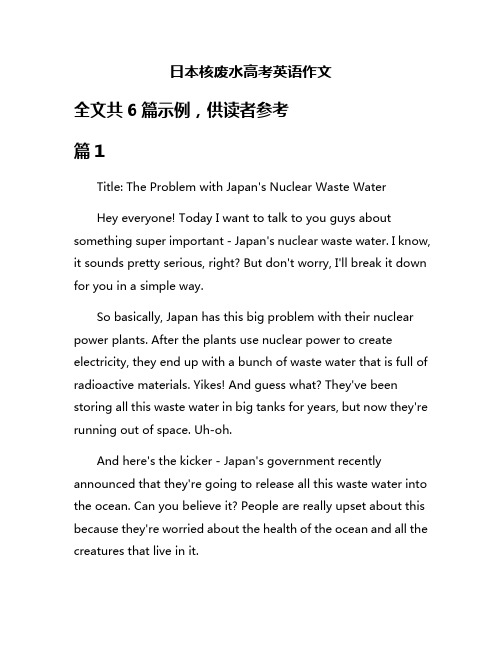
日本核废水高考英语作文全文共6篇示例,供读者参考篇1Title: The Problem with Japan's Nuclear Waste WaterHey everyone! Today I want to talk to you guys about something super important - Japan's nuclear waste water. I know, it sounds pretty serious, right? But don't worry, I'll break it down for you in a simple way.So basically, Japan has this big problem with their nuclear power plants. After the plants use nuclear power to create electricity, they end up with a bunch of waste water that is full of radioactive materials. Yikes! And guess what? They've been storing all this waste water in big tanks for years, but now they're running out of space. Uh-oh.And here's the kicker - Japan's government recently announced that they're going to release all this waste water into the ocean. Can you believe it? People are really upset about this because they're worried about the health of the ocean and all the creatures that live in it.Some scientists say that the radiation levels in the water will be very low and won't harm us or the environment. But others are not so sure. It's a pretty tough situation, and everyone is trying to figure out the best solution.In my opinion, I think Japan should try to find a different way to deal with their nuclear waste water. Maybe they can come up with a new technology or find a safer way to store it. We need to take care of our planet and make sure we're not causing any harm to it.So remember, guys, it's important to pay attention to what's happening in the world around us, even if it's something as big and scary as nuclear waste water. Let's hope Japan can find a solution that keeps our oceans safe and clean. Thanks for listening!篇2Oh my gosh! Have you heard about the news that Japan is planning to release nuclear contaminated water into the ocean? It's like super duper crazy, right?I mean, like why would they do something like that? It's like so bad for the environment and the sea animals. It's like polluting the ocean and that's not cool, man.I heard that the water they wanna release is from the Fukushima nuclear plant and it's been treated, but like still has some radioactive stuff in it. Like, that's seriously not a good idea, like at all.I think they should like find another way to deal with the water instead of just dumping it into the ocean. Maybe they can like treat it more or something, I don't know, but like there has to be a better way, right?I hope they can like listen to the people's concerns and like think twice before doing something so like harmful to our planet.I mean, we only have one Earth, right? We should like take care of it and stuff.So yeah, I hope Japan like changes their mind about releasing the nuclear water and like finds a better solution. Let's like protect the ocean and stuff, okay?That's like all I gotta say about it. Peace out!篇3Ah, hey guys! So today I wanna talk about this super important topic called "Japan's nuclear waste water", okay? Youprobably heard about it on the news, right? It's like a big deal, you know?So, Japan has this problem with their nuclear waste water from the Fukushima plant. They gotta get rid of it somehow, but they're thinking of dumping it into the ocean! Can you believe that? It's like, really bad for the environment and all the sea creatures. I mean, who wants to swim in radioactive water, right?Some people say it's okay because the water will be treated first, but others are like, no way! We can't risk it! It's a tough situation, you know?I think we should all care about this issue because it affects everyone, not just Japan. We need to think about the long-term consequences and find a better solution for the waste water. Maybe they can find a way to store it safely or come up with a new technology to clean it up. Let's protect our planet, guys!So, let's all keep an eye on what's happening with Japan's nuclear waste water and speak up if we think it's not the right thing to do. We can make a difference, even as kids! Let's be the voice for our future, okay? Thanks for listening, guys! Stay safe and take care of the Earth!篇4Oh my gosh, have you heard about the nuclear wastewater issue in Japan? It's all over the news and everybody is talking about it! So, like, Japan is planning to release this nuclear wastewater into the ocean, but a lot of people are really worried about it.Some people are like, "No way, that's so dangerous! It could harm the environment and all the sea creatures!" And other people are saying, "Well, Japan has to do something with all that wastewater from the Fukushima nuclear plant, so maybe it's the best option."I think it's really important for Japan to listen to all the concerns and make sure they're doing everything they can to protect the ocean. Maybe they could find a safer way to get rid of the wastewater, like treating it more before releasing it. Or maybe they could come up with a long-term plan to make sure this kind of thing doesn't happen again.I hope Japan makes the right decision and takes care of our planet. We all have to do our part to protect the environment, even if it's a big and complicated issue like this one. Let's all work together to make the world a better place!篇5Hey guys! Today, let's talk about the news that Japan is planning to release contaminated water from the Fukushima nuclear power plant into the ocean. It's a pretty big deal because it's been causing a lot of controversy and worry around the world.So, here's the scoop - the Fukushima nuclear power plant had a meltdown back in 2011 after a massive earthquake and tsunami hit Japan. Since then, tons of contaminated water have been stored in tanks at the site. But now, Japan is running out of space to store all this water and they're considering releasing it into the ocean.Some people think it's a bad idea because they're worried about the impact on the environment and our health. They're concerned that the contaminated water could harm marine life and even make its way into our food chain. Others argue that the water has already been treated to remove most of the radioactive substances and that it's safe to release it into the ocean.As students, we should stay informed about what's happening in the world and speak up about issues that affect our future. It's important to listen to different perspectives, do our own research, and form our own opinions. Let's keep askingquestions and raising awareness about important issues like this one!In conclusion, the decision to release contaminated water from the Fukushima nuclear power plant is a complex and controversial issue. As young people, we have a voice and a responsibility to advocate for a safe and sustainable future. Let's stay informed, speak up, and make a difference!篇6Okay, here we go!Hey guys! So have you heard about Japan's decision to release nuclear wastewater into the ocean? It's like a major issue right now. Some people are totally against it, while others think it's not a big deal. But what is it all about?Basically, Japan has a lot of nuclear wastewater stored up from the Fukushima nuclear disaster in 2011. They need to get rid of it somehow, and one option is to release it into the ocean. The thing is, this water still contains some radioactive materials, even though they have been treated to reduce the radiation levels.Some scientists say that the levels of radiation in the water are very low and won't harm us or marine life. They argue that the ocean is huge, so the radiation will be diluted and won't cause any harm. Plus, they say that we are exposed to radiation all the time from natural sources anyway.But others are worried about the potential risks. They say that even a small amount of radiation can still be harmful, especially to marine life and people who rely on the ocean for their food. They're concerned about the impact on the environment and our health in the long term.So, what do you think? Should Japan release the nuclear wastewater into the ocean or find another solution? It's a tough question, and there are valid points on both sides. Let's hope they make the right decision for everyone's sake!。
关于日本核污水的英语作文
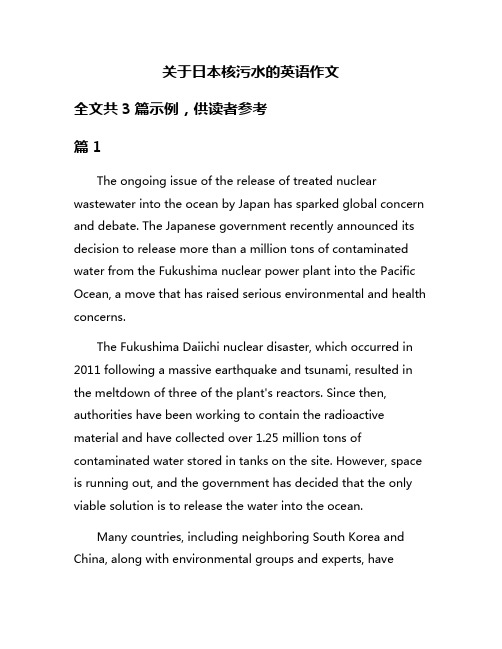
关于日本核污水的英语作文全文共3篇示例,供读者参考篇1The ongoing issue of the release of treated nuclear wastewater into the ocean by Japan has sparked global concern and debate. The Japanese government recently announced its decision to release more than a million tons of contaminated water from the Fukushima nuclear power plant into the Pacific Ocean, a move that has raised serious environmental and health concerns.The Fukushima Daiichi nuclear disaster, which occurred in 2011 following a massive earthquake and tsunami, resulted in the meltdown of three of the plant's reactors. Since then, authorities have been working to contain the radioactive material and have collected over 1.25 million tons of contaminated water stored in tanks on the site. However, space is running out, and the government has decided that the only viable solution is to release the water into the ocean.Many countries, including neighboring South Korea and China, along with environmental groups and experts, haveexpressed their opposition to Japan's plan. They argue that the release of radioactive water could have serious consequences for marine life, the fishing industry, and human health. Thelong-term effects of this decision remain unknown, and the potential risks are causing widespread concern.The Japanese government has defended its decision, stating that the treated water meets international standards and that the release will be done gradually over several decades to minimize the impact. They have also emphasized that the ocean is vast and can dilute the contaminated water to safe levels.However, many remain unconvinced and are calling for more transparency and oversight in the process. Concerns have been raised about the accuracy of the data provided by the Japanese government and the potential impact on the livelihoods of fishermen and coastal communities.In light of the growing opposition, it is essential for Japan to engage in dialogue with its neighbors and the international community to address these concerns. Transparency, accountability, and independent monitoring are crucial to ensure the safety of the environment and public health.Ultimately, the release of nuclear wastewater is a complex and challenging issue that requires careful consideration andcollaboration. Finding a solution that balances environmental protection, public health, and the needs of the affected communities is essential. Only through open dialogue and international cooperation can we address the concerns surrounding Japan's plan and work towards a sustainable and safe resolution.篇2Title: Concerns about Japan's Nuclear Contaminated WaterIntroductionIn recent years, Japan has been facing a dilemma regarding the handling of nuclear contaminated water from the Fukushima Daiichi nuclear power plant. The plant suffered a meltdown in 2011 after a massive earthquake and tsunami, leading to radioactive material leaking into the environment. The storage tanks at the plant are reaching full capacity, and the government is considering releasing treated water into the ocean. This has sparked concerns both domestically and internationally about the potential environmental and health risks.BackgroundThe Fukushima Daiichi nuclear power plant disaster in 2011 was one of the worst nuclear accidents in history, releasing largeamounts of radioactive material into the environment. Since then, workers have been treating contaminated water used to cool the reactors, removing most radioactive isotopes but not tritium. The water is stored in large tanks onsite, but these tanks are expected to reach full capacity by 2022.Potential RisksOne of the main concerns about releasing the treated water into the ocean is the impact on marine life and the fishing industry. Tritium, a radioactive isotope present in the water, can accumulate in the food chain and potentially pose health risks to humans. Furthermore, there are worries about the long-term environmental consequences of releasing contaminated water into the ocean, including damage to marine ecosystems and coastal areas.International ResponseThe potential release of nuclear contaminated water from the Fukushima plant has also drawn international attention. Many countries, including neighboring South Korea and China, have expressed concerns about the environmental impact of such a move. Environmental organizations and experts have called for more transparency and consultation from the Japanesegovernment in making decisions about the disposal of the contaminated water.ConclusionThe issue of Japan's nuclear contaminated water is a complex and challenging one that requires careful consideration of the environmental and health risks involved. While the government faces pressure to find a solution to the storage issue, it is essential to prioritize transparency and consultation with stakeholders both at home and abroad. Only through an open and informed decision-making process can Japan address the legacy of the Fukushima disaster responsibly and protect the environment for future generations.篇3Concerns Over Japan's Nuclear Contaminated WaterJapan has been facing a significant challenge in recent years with regards to the disposal of contaminated water from the Fukushima Daiichi nuclear power plant. Since the plant's catastrophic meltdown in 2011, the storage tanks at the site have been filling up with highly radioactive water that was used to cool the damaged reactors. The volume of contaminated water is steadily increasing, and Japan is running out of space to store it.The Japanese government has been considering various options to address this issue, including releasing the contaminated water into the Pacific Ocean. This proposal has sparked outrage both domestically and internationally. Many are concerned about the potential environmental impact of such a decision and the risks it poses to marine life.One of the biggest concerns is the impact on the local fishing industry. Fishermen fear that the release of contaminated water will result in a stigma on their products, making it difficult to sell their catches. The livelihoods of many in the region depend on fishing, and any damage to the industry could have devastating consequences for the local economy.Environmental activists are also voicing their opposition to the government's plan. They argue that the ocean should not be used as a dumping ground for radioactive waste and that more sustainable solutions should be explored. The long-term effects of releasing the contaminated water into the ocean are unknown, and the potential risks to human health and the environment are too great to ignore.Furthermore, neighboring countries such as South Korea and China have expressed their concerns about the potential release of the contaminated water. They fear that the radioactiveisotopes in the water could spread to their waters, contaminating their seafood and water supply. The decision to release the water into the Pacific Ocean could strain diplomatic relations between Japan and its neighbors.In light of these concerns, it is crucial for the Japanese government to carefully consider all options and engage in open dialogue with stakeholders. Transparency is key in addressing this issue, and the government must provide clear and accurate information to the public about the potential risks and benefits of each option.Ultimately, the disposal of contaminated water from the Fukushima Daiichi nuclear power plant is a complex and challenging issue that requires a thoughtful and responsible approach. The Japanese government must prioritize the safety and well-being of its citizens and the environment in making a decision on how to address this pressing issue. The world is watching, and the stakes are high.。
日本福岛第一核电站核事故最新进展
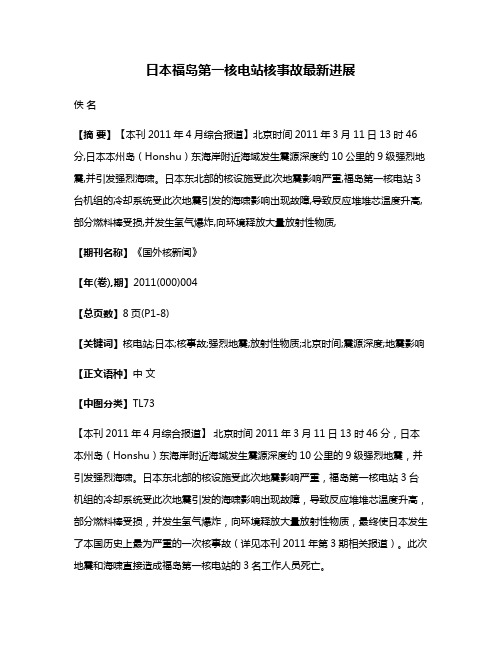
日本福岛第一核电站核事故最新进展佚名【摘要】【本刊2011年4月综合报道】北京时间2011年3月11日13时46分,日本本州岛(Honshu)东海岸附近海域发生震源深度约10公里的9级强烈地震,并引发强烈海啸。
日本东北部的核设施受此次地震影响严重,福岛第一核电站3台机组的冷却系统受此次地震引发的海啸影响出现故障,导致反应堆堆芯温度升高,部分燃料棒受损,并发生氢气爆炸,向环境释放大量放射性物质,【期刊名称】《国外核新闻》【年(卷),期】2011(000)004【总页数】8页(P1-8)【关键词】核电站;日本;核事故;强烈地震;放射性物质;北京时间;震源深度;地震影响【正文语种】中文【中图分类】TL73【本刊2011年4月综合报道】北京时间2011年3月11日13时46分,日本本州岛(Honshu)东海岸附近海域发生震源深度约10公里的9级强烈地震,并引发强烈海啸。
日本东北部的核设施受此次地震影响严重,福岛第一核电站3台机组的冷却系统受此次地震引发的海啸影响出现故障,导致反应堆堆芯温度升高,部分燃料棒受损,并发生氢气爆炸,向环境释放大量放射性物质,最终使日本发生了本国历史上最为严重的一次核事故(详见本刊2011年第3期相关报道)。
此次地震和海啸直接造成福岛第一核电站的3名工作人员死亡。
根据法国核安全与辐射防护研究院(ISRN)的估算,在地震发生约3周之后,福岛第一核电站1号机组的堆芯仍在以2.5MWt的热功率释放热量,2号和3号机组堆芯的热功率均为约4.2MWt。
如果不能通过外部循环将堆芯产生的热量排放至外部的热阱,那么这些机组的堆芯每天将分别蒸发95m3和160m3的水。
这意味着如果这些机组的冷却回路仍不能正常运转,那么就需要持续向堆芯注入冷却剂。
从3月30日开始,东京电力公司(Tepco)一直以6~8m3/h的速度向每台机组的堆芯进行注水。
东电根据安全壳内的辐射水平进行估算的结果表明,1号、2号和3号机组的堆芯中分别有70%、30%和25%的燃料棒受损。
日本福岛核电站再次爆炸 英文报道

日本福岛核电站再次爆炸!编者按:受日本大地震影响的福岛第一核电站3号反应堆,今天早上发生氢气爆炸。
当局下令核电站附近的居民留在室内,爆炸导致11人受伤。
另外,1号反应堆也冒出白烟。
首相菅直人早前形容,核电站的情况令人担忧。
The second hydrogen explosion in three days rocked Japan's stricken Fukushima Dai-ichi nuclear plant Monday, sending a massive column of smoke into the air and wounding 6 workers. The plant's operator said radiation levels at the reactor were still within legal limits.The explosion at the plant's Unit 3, which authorities have been frantically trying to cool following a system failure in the wake of a massive earthquake and tsunami, triggered an order for hundreds of people to stay indoors, said Chief Cabinet Secretary Yukio Edano.Tokyo Electric Power Co. said radiation levels at Unit 3 were 10.65 microsieverts, significantly under the 500 microsieverts at which a nuclear operator must file a report to the government.The blast follows a similar explosion Saturday that took place at the plant's Unit 1, which injured four workers and caused mass-evacuations.Japan's nuclear safety agency said 6 workers were injured in Monday's explosion but it was not immediately clear how, or whether they were exposed to radiation. They were all conscious, said the agency's Ryohei Shomi.The reactor's inner containment vessel holding nuclear rods was intact, Edano said, allaying some fears of the risk to the environment and public. TV footage of the building housing the reactor appeared to show similar damage to Monday's blast, with outer walls shorn off, leaving only a skeletal frame.More than 180,000 people have evacuated the area in recent days, and up to 160 may have been exposed to radiation.Earlier Monday, pressure had jumped inside Unit 3, forcing the evacuation of 21 workers. But they returned to work after levels appeared to ease.Associated Press journalists felt the explosion in the tsunami-devastated port town of Soma, some 25 miles (40 kilometers) north of the reactor. They reported feeling the faint rumble of a blast and the ground shaking.Four nuclear plants in northeastern Japan have reported damage, but the danger was greatest at Fukushima's Dai-ichi plant. Operators have lost the ability to cool three reactors at Dai-ichi and three more at another nearby complex using usual procedures, after the quake knocked out power and the tsunami swamped backup generators.Operators have been dumping seawater into units 1 and 3 in a last-ditch measure to cool the reactors. They were getting water into the other four reactors with cooling problems without resorting to corrosive sea water, which likely makes the reactors unusable.。
日本福岛第一核电站及其事故详解

1 号机的沸水反应堆是于 1967 年 7 月建造完工。于 1971 年 3 月 26 日开始正式进行工业发 电。原本计划于 2011 年 3 月 26 日终止运转。但是,在 2011 年日本本州岛海域地震事件中, 遭受严重损坏。1 号机设计能够抵挡尖峰地表加速度为 0.18g(1.74m/s2)的地震,其响应谱建 立于像 1952 年克恩县地震一类的地震。在尖峰地表加速度为 0.125g(1.22m/s2)长达 30 秒时 间的 1978 年宫城县地震之后,所有机组又重新经过严格检验,但并没发现反应堆的关键零 组件遭受任何损坏 。
现温度微升
6 号 沸水反应堆 3 月 15 日出
否
机 BWR-5
现温度微升
(③抢救 正灌水进入反应堆
否
否
中)
中,以冷却降温
(③抢救 正灌水进入反应堆
否
否
中)
中,以冷却降温
福岛第一核电厂事故(日语:福島第一原子力発電所事故)是2011 年3 月 11 日日本宫城县东 方外海发生矩震级规模 9.0 级大地震后所引起的一次核子事故,福岛第一核电厂因此次地震 造成有堆芯熔毁危险的事故。日本内阁官房长官枝野幸男向福岛第一核电站周边 10 千米内 的居民发布紧急避难指示,要求他们紧急疏散,并要求 3 千米至 10 千米内居民处于准备状 态。他表示:“因为核反应堆无法进行冷却,为以防万一,希望大家紧急避难。”接到指示 后,福岛县发出通报,紧急疏散辐射半径20千米范围内的居民,撤离规模为 14000 人左右。 同时此事件也是人类史上第一次在沿海地区发生核电厂意外的事件,其相关的核污染(约当 35000 颗原子弹)对于整个太平洋及沿岸国家城市的影响仍待观察统计。
2011 年日本地震的直接影响
日本福岛县

危害
※ 12万人进行核辐射检查 22人进行检查时受到核辐射(其中19名从 福岛第一核电站方圆3公里撤离人员遭到核辐射) ※ 医护人员“被传染” 福岛在核泄漏中,19名医护人员被污染,核泄漏将东京污染。 ※ 电力短缺各地轮流停电 地震和海啸中,福岛关闭了几个核反应堆。
关于评级
※ 3月12日,原子能安全 保安院将福岛第一核电站核 泄漏事故等级初步定为4级。 ※ 3月18日晚,日本原子 能安全保安院将日本福岛核 电站核泄漏事故等级从4级 提高为5级。(该核电站发 生了反应堆燃料熔毁、向外 界泄漏放射性物质的情况) ※ 日本广播协会电视台12 日报道,日本经济产业省原 子能安全保安院决定将福岛 第一核电站核泄漏事故等级 提高至7级。
日本福岛县(ふくしまけん)
日本福岛县(ふくしまけん)
• • • • • • • • • • • • • • • 中文名称: 福岛县 外文名称: ふくしま けん,Fukushima-ken 行政区类别: 县 所属地区: 日本 东北地方 下辖地区: 福岛市、伊达市、二本松市等 政府驻地: 福岛市 地理位置: 北纬38°,东经140° 面积: 13,782.75平方公里 人口: 202.5万(2011年) 方言: 福岛方言 气候条件: 夏季炎热,冬季积雪多 著名景点: 尾濑、吾妻山、猪苗代湖、会津高原 机场: 福岛机场 火车站: 福岛县火车站
福岛县最新消息
日本福岛核电站港湾鱼类放射物被检超标7400倍 2013-3-17
• 据央视报道日本东京电力公司15日宣布,从福岛第一核电站港湾内捕 捞的大泷六线鱼体内检测出每千克74万贝克勒尔的放射性铯,成为这 一地区发现的鱼类体内放射性铯浓度的最高值。 • • 这相当于日本政府规定的一般食品标准值的7400倍。食用1公斤这种 鱼,遭受的内部辐射量约为11毫希沃特,相当于照射了11至22次X射 线胸部透视。 • • 在发生核事故后,东京电力公司在港湾入口处的海底设置了高约2米 的渔网,以阻止生活在被污染海域的鱼类游到港湾外。目前,在福岛 县近海,除了对北太平洋巨型章鱼的试验性捕捞外,其他鱼类的捕捞 已停止。
日本福岛核电站事
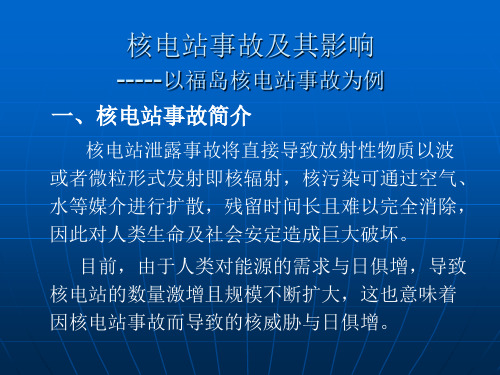
(三)事故发生的过程(1)
1、2011年3月11日下午,地震发生,控制棒 上插,反应堆安全停堆。堆芯热功率在几分钟内 由正常的1400兆瓦下降到只剩余热,但仍有约 4%,虽然仍在下降,但下降速度变慢。 2、停堆后应保证厂用电源不失,由安注系统 向堆芯补水,保证堆芯冷却防止超压,但地震摧 毁了电网,厂外电源不可用;应急柴油机很争气 的起来了,向堆芯内注入清水。注意是清水,不 是硼水,换句话说,操作员采用了比较保守的方 法。
史上发生的数次著名的核电站事故
二、日本福岛核电站事故及其 影响
主要内容
(一)背景 (二)事故原因 (三)事故发生的过程 (四)事故教训 (五)后续影响
(一)背景
2011年3月11日下午,日本东部海域发生里氏9.0级 大地震,并引发海啸。位于日本本州岛东部沿海的福岛第 一核电站停堆,且若干机组发生失去冷却事故,3月12日 下午,一号机组发生爆炸。3月14日,三号机组发生两次 爆炸。日本经济产业省原子能安全保安院承认有放射性物
与事故相关的沸水堆的特点(2)
2.沸水堆正常工作于沸腾状态 这句话基本上相当于废话,沸水堆当 然是沸腾态的。但是这也决定了沸水堆的 事故工况与正常工况有类似之外,而压水 堆则正常工作于过冷状态,失水事故时发 生沸腾,与正常工况差别较大。 这个特点,会使操作员抱有更大的侥 幸心理。
与事故相关的沸水堆的特点(3)
(四)事故教训(4)
4、关于辐射监测的问题 不知和中国一山之隔的海参崴有没有 辐射监测站,但是,离中国直线距离最近 的吉林延边和黑龙江牡丹江好像是没有的。 长春和沈阳有,但如果大城市监测到似乎 有点晚了。朝鲜核电站投产似乎也不远了, 某些边境增加辐射监测点还是很有必要的。
福岛核电站中的LOCA和熔芯事故 共18页PPT资料

概要
福岛历史及堆形 福岛事故的LOCA过程 福岛事故中的熔芯过程
福岛核电站的历史及堆形
福岛核电站(Fukushinia Nuclear Power Plant)位于北纬37度25分 14秒,东经141度2分,地处日本福 岛工业区。福岛核电站是目前世界世 界最大的核电站,由福岛一站 (daiichi)、福岛二站(daini)组成,共 10台机组(一站6台,二站4台), 均为沸水堆。
福岛周边地理分布
福岛核电站历史
福岛第一和第二核电站此前也多次发生事故。其中福岛第一核电站1978年 曾经发生临界事故,但是事故一直被隐瞒至2019年才公诸于众。
2019年8月里氏7.2级地震导致福岛县两座核电站中存储核废料的水池部分 池水外溢。
2019年,福岛第一核电站6号机组曾发生放射性物质泄漏事故。 2019年,东京电力公司承认,从1977年起在对下属3家核电站总计199次
3/4堆芯裸露 包壳温度超过1200度 锆水反应发生
Zr + 2H20 →ZrO2 + 2H2 反应放出的热量进一步使堆
芯升温 产生氢气
—1号机组: 300~600kg —2/3号机组: 300~1000kg 氢气通过湿井进入干井
福岛核电站事故分析
安全壳降压的积极和消极 影响
堆形示意图
1号机组:通用电气设计沸水堆核电站 (439 MW), 1971年投入运行 2-4号机组 :通用电气设计沸水堆核电站 (760 MW), 1974年投入运行
堆形示意图
厂房
安全壳
沸水堆Βιβλιοθήκη 压水堆厂房和安全壳示意图
反应堆维护层 (不锈钢结构)
福岛核污染事件时间线

福岛核污染事件时间线
福岛核污染事件的时间线如下:
2011年3月11日:日本发生9.0级地震和海啸,福岛核电站
发生多个反应堆失控,导致核泄漏。
2011年3月12日:福岛第一号反应堆发生爆炸,核物质泄露
到环境中。
2011年3月15日:福岛第二号反应堆发生爆炸,继续泄漏放
射性物质。
2011年3月16日:福岛第三号反应堆发生爆炸,核事故升级
为七级(最高级别)。
2011年3月17日:日本政府宣布周围20公里范围内的居民
撤离,恢复工作人员进入核电站进行救援工作。
2011年4月12日:福岛第四号反应堆发生火灾,但并未爆炸。
2011年12月16日:日本政府正式宣布福岛核事故得到冷却
控制,但还需长期处理和监测。
2013年8月修正:
- 自2012年12月起,日本政府开始解禁福岛核事故灾区的部
分地区,并将其划分为不同的“核事故辐射影响区域”。
- 2013年4月,日本政府将福岛核事故的事件级别从七级调整
为三级,与切尔诺贝利核事故相同的级别。
- 2015年12月,日本政府宣布在福岛核电站周围的准备就绪,以在未来四十年内进行拆除和处置核电站。
- 2018年1月,位于福岛核电站附近的地下冻土墙被宣布为首
次有效阻止周边地下水流入核电站的措施。
2021年修正:
- 福岛核污染事件迄今已持续十年,核电站的拆除和处置工作
仍在进行中,并将继续监测辐射情况以确保公众的安全。
福岛核电站事故及相关基础知识
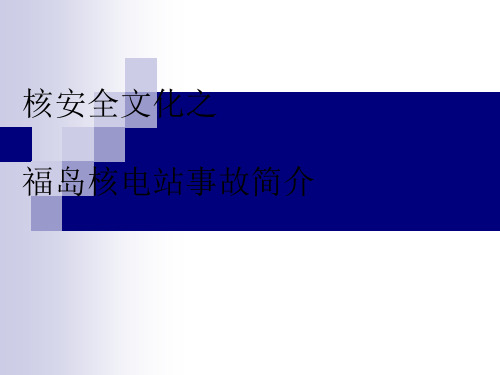
辐射剂量的单位: 辐射剂量的单位: 吸收剂量,戈瑞Gy、mGy、µGy、nGy 剂量当量,希弗Sv、mSv、µSv、nSv
辐射防护基本知识
电离辐射对人体的危害主要在于, 电离辐射对人体的危害主要在于,辐射的能量导致构成人体组织的细 胞受到损伤。其引起的生物效应主要有两种分类方法: 胞受到损伤。其引起的生物效应主要有两种分类方法:分为躯体效应和遗 传效应;或分为随机性效应和确定性效应 。 传效应; 国际放射防护委员会研究报告表明,累计剂量小于100mSv未观察到生 国际放射防护委员会研究报告表明,累计剂量小于 未观察到生 物效应 国家国标规定的职业照射剂量限值为连续5年剂量平均值 年剂量平均值20mSv 国家国标规定的职业照射剂量限值为连续 年剂量平均值
核电站的安全设计
核电站的安全设计
选址 关于地震 大亚湾核电站位于欧亚板块的东南部的沿海地带, 远离构造变形强烈的南北构造带和菲律宾海板块俯冲 带,厂址附近无断裂带,历史上也未出现过超过5级 的地震,大亚湾核电站厂址附近出现与本次震级相当 的地震概率非常低。 关于海啸 海啸的形成通常由里氏6.5级以上规模的深海地震 引起,且海水深度达到1000米量级才可能形成规模较 大的海啸。广东省沿海属于边缘海,海水深度较浅, 只有二三十米,难以形成大规模海啸,我国海岸记录 到的海啸最高在0.5米以下。大亚湾核电站在设计时 布置有防波堤,防波堤高11.22米。
辐射防护基本知识 福岛电站核泄漏对中国的影响
根据日本方面监测到的信息,福岛核电站事故释放的放射性 物质主要是碘131、 铯137。目前日本政府发出的核事故应 急指令20公里内撤离,20-30公里隐蔽。 放射性物质的运动方式主要有:自身衰变、沉降、随云层迁 徙、水洋流迁徙、稀释等方式。从福岛到我国最近的距离约 1000公里,到北京、上海约2000公里,到深圳、香港约 3000公里。放射性物质即使扩散到中国境内其影响也十分有 限,对人体健康不会产生任何伤害 注:放射性物质其中I131的半衰期约8.08天,Cs137半衰期 30.17年。
日本排核废水的英语作文
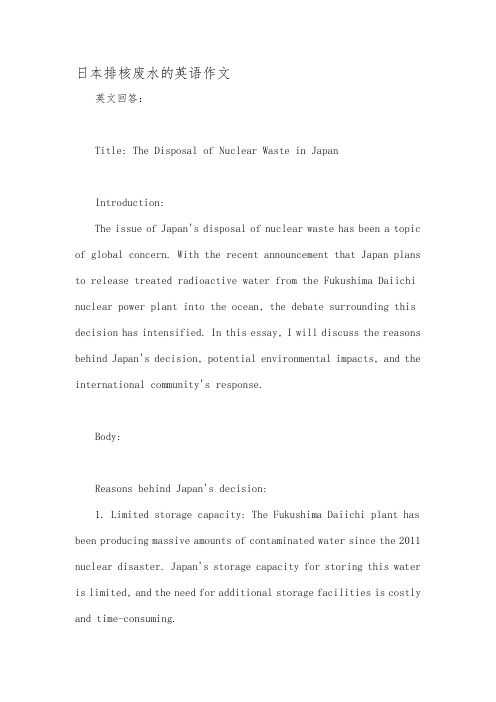
日本排核废水的英语作文英文回答:Title: The Disposal of Nuclear Waste in JapanIntroduction:The issue of Japan's disposal of nuclear waste has been a topic of global concern. With the recent announcement that Japan plans to release treated radioactive water from the Fukushima Daiichi nuclear power plant into the ocean, the debate surrounding this decision has intensified. In this essay, I will discuss the reasons behind Japan's decision, potential environmental impacts, and the international community's response.Body:Reasons behind Japan's decision:1. Limited storage capacity: The Fukushima Daiichi plant has been producing massive amounts of contaminated water since the 2011 nuclear disaster. Japan's storage capacity for storing this water is limited, and the need for additional storage facilities is costly and time-consuming.2. Water treatment: The treated water is claimed to meet safety standards set by the International Atomic Energy Agency (IAEA). Japan argues that releasing the water into the ocean is a safe and viable solution.Potential environmental impacts:1. Marine ecosystem: Critics argue that the release of radioactive water may harm marine life and disrupt the delicate balance of the ocean ecosystem. The long-term effects on fish, marine plants, and other organisms are still uncertain.2. Public perception: The release of nuclear waste into the ocean may raise concerns among the public regarding the safety of seafood and the potential health risks associated with consuming contaminated products.International response:1. Concerns from neighboring countries: South Korea, China, and other neighboring countries have expressed their concerns over the potential impact of Japan's decision on their own coastal areas and fishing industries.2. Calls for transparency: The international community has urged Japan to provide transparent and detailed information about thewater treatment process, monitoring plans, and potential risks to ensure the decision is made with the highest regard for safety.Conclusion:The disposal of nuclear waste is a complex and contentious issue. Japan's decision to release treated radioactive water into the ocean has sparked a global debate. While Japan argues that it is a safe and necessary solution, concerns about potential environmental impacts and public perception remain. International cooperation and transparency are crucial in addressing these concerns and ensuring the safety of our oceans and ecosystems.中文回答:标题:日本核废水的处理介绍:日本处理核废水的问题已成为全球关注的话题。
日本核废水的英语作文
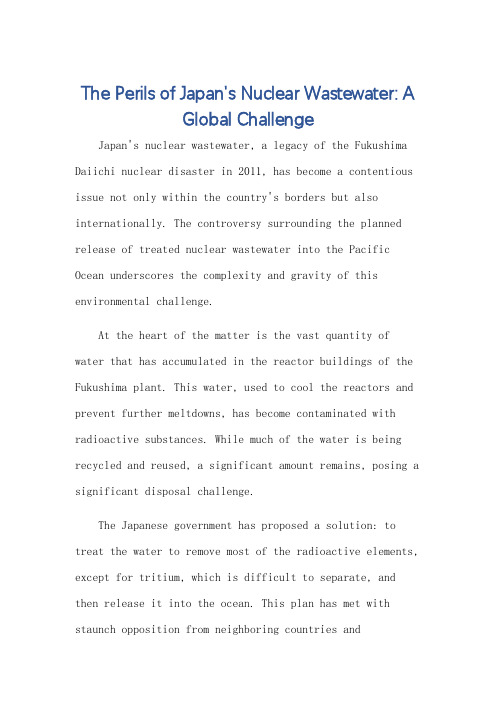
The Perils of Japan's Nuclear Wastewater: AGlobal ChallengeJapan's nuclear wastewater, a legacy of the Fukushima Daiichi nuclear disaster in 2011, has become a contentious issue not only within the country's borders but also internationally. The controversy surrounding the planned release of treated nuclear wastewater into the Pacific Ocean underscores the complexity and gravity of this environmental challenge.At the heart of the matter is the vast quantity of water that has accumulated in the reactor buildings of the Fukushima plant. This water, used to cool the reactors and prevent further meltdowns, has become contaminated with radioactive substances. While much of the water is being recycled and reused, a significant amount remains, posing a significant disposal challenge.The Japanese government has proposed a solution: to treat the water to remove most of the radioactive elements, except for tritium, which is difficult to separate, and then release it into the ocean. This plan has met with staunch opposition from neighboring countries andenvironmental organizations, who fear the potential impact on marine ecosystems and human health.The concerns are not unfounded. Tritium, whilerelatively weak in its radioactive properties, can accumulate in organisms and potentially pose long-term risks. The ocean is a highly connected ecosystem, and any contamination could potentially spread through marine currents, affecting a wide range of species and potentially human food chains.Moreover, the international community remains divided on the issue. While some countries understand the practical difficulties Japan faces in disposing of the nuclear wastewater, many others express concerns about thepotential transboundary impacts. This divergence of opinion highlights the need for a coordinated and science-based approach to addressing this global challenge.In this context, it is crucial that Japan proceeds with utmost caution and transparency. The treatment process must be rigorously tested and verified to ensure the safety of the released water. Additionally, Japan should engage in meaningful dialogue with its neighbors and theinternational community to address concerns and explore alternative solutions.Furthermore, the international community must also come together to develop a comprehensive framework for managing nuclear waste and preventing future disasters. This includes improving nuclear safety standards, enhancing emergency response capabilities, and promoting research on sustainable and safe waste disposal methods.In conclusion, Japan's nuclear wastewater presents a complex and urgent environmental challenge that requires a concerted global effort to address. It is imperative that we approach this issue with a balance of scientific rigor, environmental responsibility, and international cooperation to ensure the safety of our shared ocean and planet.**日本核废水的危机:全球性的挑战**2011年福岛第一核电站灾难遗留下来的日本核废水问题,不仅在国内引发争议,而且已经上升为国际层面上的热议话题。
福岛核电站事故分析报告
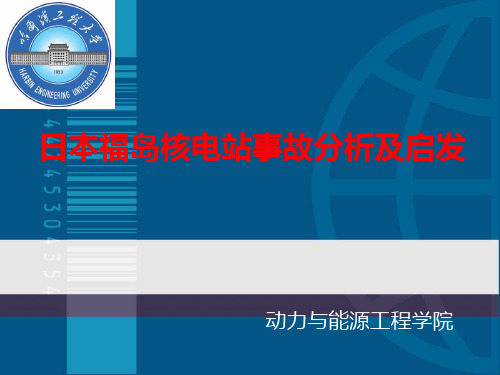
福岛一站1号机组于1971年3月投入商业运行,二站1号机组于1982年4月投入商业运行。 福岛核电站的核反应堆都是单循环沸水堆,只有一条冷却回路,蒸汽直接从堆芯中产生, 推动汽轮机。福岛核电站一号机组已经服役40年,已经出现许多老化的迹象,包括原子 炉压力容器的中性子脆化,压力抑制室出现腐蚀,热交换区气体废弃物处理系统出现腐 蚀。这一机组原本计划延寿20年,正式退役需要到2031年。2011年东京电力计划为第一 核电站增建两座反应堆。
我国核电与福岛核电站相比:
福岛
地震 海啸 技术标准 安全壳承压能力 安全壳消氢 全厂断电 严重事故管理导则 地震带 发生 60年代 较弱 无 汽动泵 无
我国
地质结构稳定 基本不具备发生条件 90年代 较强 能动+非能动 汽动泵+非能动系统 已有并全面推广
无论对二代还是三代核电站、压水堆还是沸水堆,福岛核 电站严重事故均给我们很多改进启示: 1. 厂址抗震能力--厂址选择 2. 厂址防海啸、洪水能力--设计考虑和现行改进 3. 预防严重事故发生--应急电源、应急水源 4. 严重事故缓解--氢气复合器、过滤排放、SAMG 5. 应急响应能力--公众撤离 6. 事故后续处理、放射性物质处理--设备、技术
在能源紧缺的当下,核电事业不应受到此类事故的影响,安全合理的发展核 电事业势在必行。 当然,在核电站运行过程中,从上倒下贯彻安全意识是十 分必要的。在实际工作中,应保持严谨的态度,坚守各自工作岗位,维持核 电的安全运行。 中国正在运行和建造以及待建造的各核电站十分重视应对各 类突发事件的考量。中国最早的核电站浙江秦山核电站和广东大亚湾核电站
福岛核电站爆炸-泄漏事故图解
地震造成了怎样的损害
周五的地震切断了系统 的电源,海啸还瘫痪了备用 的柴油发电机。作为第三备 份,蒸汽驱动的汽轮机本该 产生足够的电力,驱动水泵 将冷却水注入反应罩内。然 而控制反应堆运行的电量已 经耗尽,只能等待启用新的 柴油发电机。报告称2号反应 堆的燃料棒因缺水导致暴露。 1号反应堆也出现冷却剂泄漏 的状况,控制室的辐射水平 不断上升。
核辐射
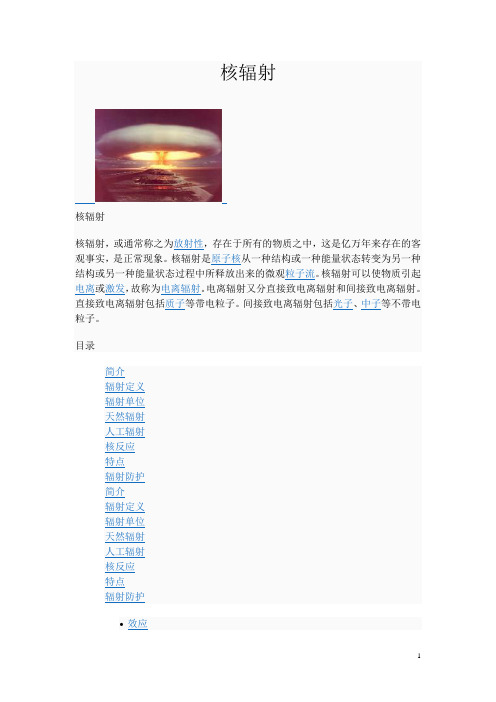
核辐射核辐射核辐射,或通常称之为放射性,存在于所有的物质之中,这是亿万年来存在的客观事实,是正常现象。
核辐射是原子核从一种结构或一种能量状态转变为另一种结构或另一种能量状态过程中所释放出来的微观粒子流。
核辐射可以使物质引起电离或激发,故称为电离辐射。
电离辐射又分直接致电离辐射和间接致电离辐射。
直接致电离辐射包括质子等带电粒子。
间接致电离辐射包括光子、中子等不带电粒子。
目录简介辐射定义辐射单位天然辐射人工辐射核反应特点辐射防护简介辐射定义辐射单位天然辐射人工辐射核反应特点辐射防护•效应•防辐原则•剂量限值•核辐射效应•辐射最可能导致哪些长期的健康损害•辐射环境•核辐射对人体的危害•核辐射的危害原理:•核电站事故一览•预防核辐射•核泄漏防护知识•个人核辐射防护•碘对核辐射的作用•黄滑松茸对核辐射的作用•核辐射 - 污染展开编辑本段简介核反应是指入射粒子(或原子核)与原子核(称靶核)碰撞导致原子核状态发生变化或形成新核的过程。
反应前后的能量、动量、角动量、质量、电荷与宇称都必须守恒。
核反应是宇宙中早已普遍存在的极为重要的自然现象。
现今存在的化学元素除氢以外都是通过天然核反应合成的,在恒星上发生的核反应是恒星辐射出巨大能量的源核辐射泉。
此外,宇宙射线每时每刻都在地球上引起核反应。
自然界的碳14大部分是宇宙射线中的中子轰击氮14产生的。
1919年英国的E.卢瑟福用天然放射性物质的α粒子轰击氮,首次用人工实现了核反应。
30年代初加速器的出现和40年代初反应堆的建成,为研究核反应提供了强有力的工具。
目前已能将质子加速到5×10^5兆电子伏,将铀原子核加速到约9×10^4兆电子伏,并能获得介子束。
高分辨率半导体探测器的使用,大大提高了测量核辐射能量的精度。
核电子学和计算机技术的发展,从根本上改善了数据的获取和处理能力。
在过去半个多世纪里,研究过的核反应数以千计,制备出了自然界不存在的放射性核素约2000种,发现了300余种基本粒子,获得了有关核素性质、核转变规律、核结构、基本粒子以及自然界四种相互作用的规律和相互联系的大量知识。
日本福岛核电站事故简介与分析
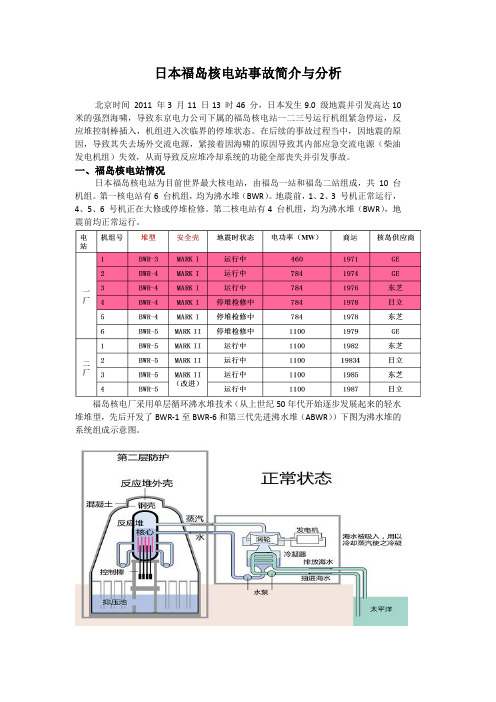
日本福岛核电站事故简介与分析北京时间2011 年3 月11 日13 时46 分,日本发生9.0 级地震并引发高达10 米的强烈海啸,导致东京电力公司下属的福岛核电站一二三号运行机组紧急停运,反应堆控制棒插入,机组进入次临界的停堆状态。
在后续的事故过程当中,因地震的原因,导致其失去场外交流电源,紧接着因海啸的原因导致其内部应急交流电源(柴油发电机组)失效,从而导致反应堆冷却系统的功能全部丧失并引发事故。
一、福岛核电站情况日本福岛核电站为目前世界最大核电站,由福岛一站和福岛二站组成,共10 台机组。
第一核电站有6 台机组,均为沸水堆(BWR)。
地震前,1、2、3 号机正常运行,4、5、6 号机正在大修或停堆检修。
第二核电站有4 台机组,均为沸水堆(BWR),地震前均正常运行。
福岛核电厂采用单层循环沸水堆技术(从上世纪50年代开始逐步发展起来的轻水堆堆型,先后开发了BWR-1至BWR-6和第三代先进沸水堆(ABWR))下图为沸水堆的系统组成示意图。
福岛MARK I(左图)为双层安全壳,内层为钢衬安全壳(梨形),设计压力4bar 左右,容积较小(数千立方米),外层非预应力混凝土安全壳。
钢安全壳由干井和湿井构成,干井中间是压力容器。
湿井为环形结构,里面装了4000吨的水,起过滤放射性物质和抑制安全壳内压力作用。
福岛一站的MARKII(右图)安全壳在MARK I基础上进行了简化设计,内层钢安全壳改为圆锥形,干井直接位于湿井上方,湿井改为圆柱形结构,两者之间通过导管相连。
B.应急冷却系统下图分别为BWR3和BWR4的应急冷却系统示意图。
福岛第一核电厂的沸水堆在设计时并未考虑反应堆堆芯的风险及应对措施,在三里岛和切尔诺贝利事故后,开始关注超设计基准事故和严重事故。
日本政府认为日本的反应堆安全设计可以保证安全,不必要在在法规上进一步的对严重事故再加以要求,主要靠业主自主开展提升安全和降低风险方面的工作。
原子力安全保安院”(NISA)让业主采用PSA手段进行风险研究,并研制事故规程(AM),针对超设计基准事故和严重事故。
英语听力材料《核辐射的影响》

英语听力材料《核辐射的影响》英语听力材料《核辐射的影响》核辐射,或通常称之为放射性,存在于所有的物质之中,这是亿万年来存在的客观事实,是正常现象。
但是核辐射对于现代经济与生活都会造成比较大的影响。
下面,我们来分享一份关于核辐射的英语听力材料。
Japan's nuclear crisis may mean greater demand for imported food and less competition from Japanese products on world markets. But it also means that Japanese farmers and others who make and sell food have to worry about their future.日本陷入了核危机,这意味着日本对进口食品的需求量增大,而其产品在世界市场上的竞争力也会因此减弱。
但是同时也意味着日本农民以及其他制造和销售食品的人要为自己的未来担忧了。
Yasumichi Tanaka sells fish at one of Japan's busiest fish markets. But now there are fewer fish to sell. He says: "Fish supplies from the radiation-contaminated regions have been totally halted."安通·藤村俊二在日本最繁忙的一个鱼市买鱼。
但是现在鱼的供货量减少。
他说:“受到辐射污染的.地区的鱼已经完全停止供货。
”The rediation is from the Fukushima nuclear power station that was damaged by the March eleventh earthquake and tsunami. The extent of the problems are still not clear.辐射来源于在3月11日的地震和海啸中受损的福岛核电站。
中考英语作文常用句型(有例句)

中考英语作文常用句型A.开头常用句型1.It is said that… 从句“据说……〞It is said that Jay Chou will visit our school next week.据说周杰伦下周会参观我们学校。
2.It is reported that… 从句“据报道……〞It is reported that some nuclear radiation from Fukushima of Japan has gone into the sea.据报道,局部日本福岛核辐射已经进入海洋。
3.It is believed that 从句“一般认为……〞It’s believed that eating more fruits and vegetables is good for our health.一般认为多吃水果和蔬菜有助于身体健康。
4.It is necessary (for sb.) to do / that……是必要的It’s necessary for us to learn a foreign language. 学习一门外语对我们来说是很有必要的。
5.It is important/essential (for sb.) to do / that…… 是重要的As we know, it is important for us to master a foreign language.众所周知,掌握一门外语是非常重要的。
6.It is proper (for sb.) to do / that …… 是适当的It is proper that we (should) keep the public places clean. 我们应当保持公共场所清洁。
7.It is urgent (for sb.) to do / that ……是紧急的It’s urgent for us to protect the environment now.现在对我们来说保护环境是非常紧迫的。
- 1、下载文档前请自行甄别文档内容的完整性,平台不提供额外的编辑、内容补充、找答案等附加服务。
- 2、"仅部分预览"的文档,不可在线预览部分如存在完整性等问题,可反馈申请退款(可完整预览的文档不适用该条件!)。
- 3、如文档侵犯您的权益,请联系客服反馈,我们会尽快为您处理(人工客服工作时间:9:00-18:30)。
日本福岛核电站再次爆炸!
编者按:受日本大地震影响的福岛第一核电站3号反应堆,今天早上发生氢气爆炸。
当局下令核电站附近的居民留在室内,爆炸导致11人受伤。
另外,1号反应堆也冒出白烟。
首相菅直人早前形容,核电站的情况令人担忧。
The second hydrogen explosion in three days rocked Japan's stricken Fukushima Dai-ichi nuclear plant Monday, sending a massive column of smoke into the air and wounding 6 workers. The plant's operator said radiation levels at the reactor were still within legal limits.
The explosion at the plant's Unit 3, which authorities have been frantically trying to cool following a system failure in the wake of a massive earthquake and tsunami, triggered an order for hundreds of people to stay indoors, said Chief Cabinet Secretary Yukio Edano.
Tokyo Electric Power Co. said radiation levels at Unit 3 were 10.65 microsieverts, significantly under the 500 microsieverts at which a nuclear operator must file a report to the government.
The blast follows a similar explosion Saturday that took place at the plant's Unit 1, which injured four workers and caused mass-evacuations.
Japan's nuclear safety agency said 6 workers were injured in Monday's explosion but it was not immediately clear how, or whether they were exposed to radiation. They were all conscious, said the agency's Ryohei Shomi.
The reactor's inner containment vessel holding nuclear rods was intact, Edano said, allaying some fears of the risk to the environment and public. TV footage of the building housing the reactor appeared to show similar damage to Monday's blast, with outer walls shorn off, leaving only a skeletal frame.
More than 180,000 people have evacuated the area in recent days, and up to 160 may have been exposed to radiation.
Earlier Monday, pressure had jumped inside Unit 3, forcing the evacuation of 21 workers. But they returned to work after levels appeared to ease.
Associated Press journalists felt the explosion in the tsunami-devastated port town of Soma, some 25 miles (40 kilometers) north of the reactor. They reported feeling the faint rumble of a blast and the ground shaking.
Four nuclear plants in northeastern Japan have reported damage, but the danger was greatest at Fukushima's Dai-ichi plant. Operators have lost the ability to cool three reactors at Dai-ichi and three more at another nearby complex using usual procedures, after the quake knocked out power and the tsunami swamped backup generators.
Operators have been dumping seawater into units 1 and 3 in a last-ditch measure to cool the reactors. They were getting water into the other four reactors with cooling problems without resorting to corrosive sea water, which likely makes the reactors unusable.。
